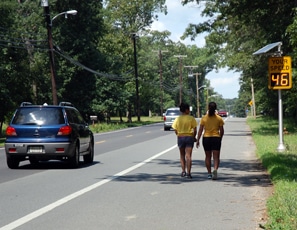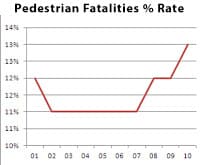Pedestrian safety and traffic calming have an ongoing, interconnected relationship. Concerns for pedestrian safety are often the
impetus behind traffic calming, whether it is on a municipal road, in a private
community, or on a corporate campus. In turn, the goal of traffic calming is to
slow cars down and make cars safer for pedestrians and bicyclists.
 |
| Pedestrians walk past SafePace 400 speed display sign |
Each year, pedestrian fatalities comprise about 12% of
traffic fatalities in the US. A NHTSA report released
in August 2012 reports 4,280 pedestrian fatalities in 2010 and an estimated
70,000 pedestrian injuries. While the number of pedestrian fatalities has
decreased in the past decade, from 2009 to 2010 it has increased by 4%. Final
pedestrian fatality data is not readily available for 2011 or 2012, however, a
report estimating fatalities for the first quarter of 2012 shows higher overall
fatality rates, which very likely translates to higher pedestrian fatalities as
well. The 2010 pedestrian fatalities account for the largest percentage of
total traffic fatalities in over ten years.
 |
| Percentage of traffic fatalities that took the lives of pedestrians |
and injured every eight minutes. Each of these deaths and injuries
is preventable.
traffic crashes in 2010, approximately 23% were age 15 or younger. Safekids.org,
a nationwide child safety organization, documents that the highest percentage
of fatalities among pedestrians age 14 and under was between 4 pm and 8 pm, the
hours when children are out of school. 74% of these fatalities occurred at
non-intersection locations. In addition,
the last five years have seen a 25% increase in injuries among 16-19 year olds.
On average, 61 kids are injured by cars every day. These injuries are avoidable
with the right planning and foresight. The responsibility to prevent these
injuries is dual; cities need to implement solutions to slow cars in areas
where children walk and schools and families need to educate children about how
to navigate traffic safely.
school, spearheaded by the national Safe Routes to School program, has helped get
more students walking or cycling to their schools. In addition to the physical
benefits of consistent exercise, the increase may also be protecting children
from car-related injuries. Safekids.org reports that policies that increase the
number of pedestrians and cyclists actually improve their safety.
risk of injury to pedestrians. In a CDC study entitled Reducing Childhood Pedestrian Injuries, the CDC lists traffic
calming measures such as street narrowing or speed humps as a valuable tool to
protect pedestrians and bicyclists. Flashing beacons have been found to slow
cars around schools by 5-7 mph and are a good solution for school zones or any
area with high pedestrian traffic. Driver feedback signs can be used to slow
cars by alerting drivers while dynamic signs such as the SafePace 600 and
SafePace 700 signs can issue different messages based on driver behavior. The newly released SafePace 800 can also be
programmed to show a full matrix graphic such as pedestrians crossing and can
be used as a speed display sign as well.
solution is to identify the specific problem to address. There are many
different safety issues that affect pedestrian and bicyclist safety and a
solution that works for one issue may not be appropriate for another.
Stay posted for a more in depth discussion about how to create a program
to protect pedestrians on your streets.







